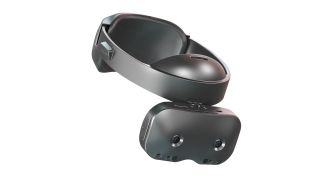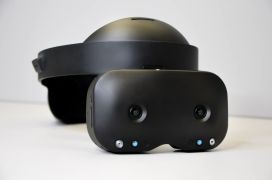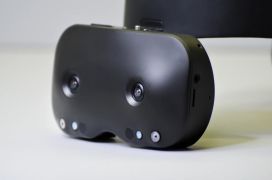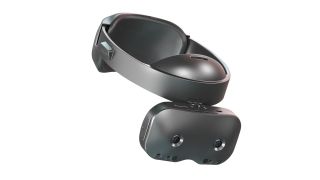Lynx R1
| Lynx R1 | |
|---|---|
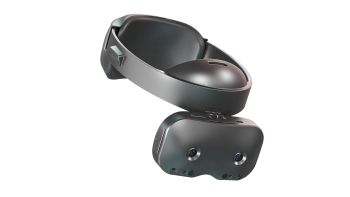
| |
| Basic Info | |
| VR/AR | Virtual Reality, Mixed Reality |
| Type | Head-mounted display |
| Subtype | Standalone VR |
| Platform | Android 10 (modified), Unity3D, OpenXR |
| Creator | Stan Larroque |
| Developer | Lynx Mixed Reality |
| Manufacturer | Compal |
| Announcement Date | February 3, 2020 |
| Release Date | November 18, 2022 (Initial shipments), 2023 (General availability) |
| Price | $849 (Standard Edition), $1299 (Enterprise Edition) |
| Website | https://www.lynx-r.com/ |
| Versions | Standard Edition, Enterprise Edition, Limited Edition (Kickstarter Transparent) |
| Requires | None (Standalone device) |
| Predecessor | None |
| Successor | None |
| System | |
| Operating System | Android 10 (modified Lynx OS) |
| Chipset | Qualcomm Snapdragon XR2 Gen 1 (7nm) |
| CPU | Kryo 585 octa-core (within XR2) |
| GPU | Adreno 650 |
| HPU | None |
| Storage | |
| Storage | 128 GB UFS 3.1 |
| Memory | 6 GB LPDDR5 (8 GB in some Enterprise models) |
| SD Card Slot | Yes (MicroSD, up to 1TB) |
| Display | |
| Display | Dual LCD (binocular) |
| Subpixel Layout | RGB stripe |
| Resolution | 1600×1600 per eye |
| Pixel Density | ~18 PPD (pixels per degree) |
| Refresh Rate | 90 Hz |
| Persistence | Low persistence |
| Image | |
| Field of View | 90°×90° (circular) |
| Horizontal FoV | 90° |
| Vertical FoV | 90° |
| Foveated Rendering | No |
| Optics | |
| Optics | 4-fold catadioptric freeform prism |
| Ocularity | Binocular |
| IPD Range | 56-72 mm (manually adjustable) |
| Adjustable Diopter | No |
| Passthrough | Yes (Full-color stereo RGB passthrough) |
| Tracking | |
| Tracking | 6DOF inside-out tracking |
| Base Stations | None (inside-out tracking) |
| Eye Tracking | No (removed for consumer version, originally planned) |
| Face Tracking | No |
| Hand Tracking | Yes (Ultraleap optical) |
| Body Tracking | No |
| Rotational Tracking | Yes (6DOF) |
| Positional Tracking | Yes (6DOF) |
| Audio | |
| Audio | Built-in stereo speakers |
| Microphone | Yes (2 integrated microphones) |
| 3.5mm Audio Jack | Yes (TRRS) |
| Camera | 6 cameras total: 2 B&W (6DOF tracking), 2 IR (hand tracking), 2 RGB (passthrough) |
| Connectivity | |
| Connectivity | Wi-Fi 6 (802.11ax), Wi-Fi 5, USB-C (3.1 Gen1, DisplayPort Alt-Mode) |
| Ports | USB-C, 3.5mm audio jack, MicroSD slot |
| Wired Video | Yes (via USB-C tethering to PC) |
| Wireless Video | Yes (Wi-Fi streaming) |
| WiFi | Wi-Fi 6 (802.11ax), Wi-Fi 5 |
| Bluetooth | Bluetooth 5.0 |
| Power | USB-C charging |
| Battery Life | 2-3 hours active use |
| Charge Time | ~2.5 hours |
| Device | |
| Dimensions | Compact form factor |
| Weight | 500g (headset alone), 700g with strap and foam |
| Material | Polycarbonate-ABS housing |
| Headstrap | Halo-style fabric headstrap with flip-up visor |
| Haptics | No (headset), Yes (optional controllers) |
| Color | Black (Standard), Transparent front (Limited Edition) |
| Sensors | Accelerometer, Gyroscope, Magnetometer, 6 cameras |
| Input | Hand tracking, optional 6DOF controllers based on Finch Technologies Shift |
| Compliance | CE, FCC, GDPR compliant |
| Size | Compact form factor |
| Cable Length | 1m USB-C cable included |
The Lynx R1 is a standalone virtual reality and mixed reality head-mounted display developed by French startup Lynx Mixed Reality. Announced on February 3, 2020, and released between November 2022 and 2023, it was the first standalone headset designed from the ground up to support both virtual reality (VR) and augmented reality (AR) experiences through video passthrough.[1] The device features a unique optical system using 4-fold catadioptric freeform prisms, allowing for a more compact design compared to traditional Fresnel lens-based headsets.[2]
History
Development
Lynx Mixed Reality was founded in 2019 by Stan Larroque, who discovered the field of VR/AR in late 2016 while using an Oculus DK2 at his school.[3] The company started with a team of 15 people with various backgrounds ranging from designers to electronics engineers.[4]
The Lynx R1 was first publicly revealed at the SPIE Photonics West conference in San Francisco on February 3, 2020, where Larroque presented the headset's unique optical approach during an online presentation.[2] Initially positioned primarily for enterprise applications with a planned price of $1,500, the device was set to ship in summer 2020 with pre-orders available for a $150 down payment.[2]
Kickstarter Campaign
In October 2021, Lynx launched a Kickstarter campaign for the R1 headset, pivoting toward a wider consumer audience and removing the originally planned eye tracking feature to reduce costs. The campaign was highly successful, reaching its funding goal in under 15 hours and ultimately raising €725,281 (approximately $835,000) from 1,216 backers.[5] The Kickstarter offered different tiers, with the consumer version starting at €530 ($500 without European VAT) and the Professional Edition at €950 ($900 without VAT).[5] Backers could opt for a Limited Edition version featuring a transparent front faceplate.[6]
Production and Delays
Following multiple pandemic-related supply chain delays, production began at contract manufacturer Compal in mid-2023.[7] The first certified retail units shipped to Kickstarter backers on November 18, 2022, with general availability following in 2023.[8]
Funding and Investment
In May 2022, Lynx announced it had secured $4 million in Series A funding led by Somnium Space, a social VR platform company. This funding round aimed to help establish Lynx as the "European Champion of Mixed Reality."[9]
Technical Specifications
Display and Optics
The Lynx R1 uses two LCD displays, each with a resolution of 1600×1600 pixels per eye, running at a 90 Hz refresh rate.[10] The headset's most distinctive feature is its optical system, which employs 4-fold catadioptric freeform prisms instead of traditional Fresnel lenses.[2] This innovative lens design allows the displays to sit flush with the lenses, creating a more compact form factor than conventional VR headsets and enabling the characteristic flip-up visor design.[2]
The field of view is 90 degrees in a circular shape, providing approximately 18 pixels per degree (PPD), which is comparable to the Meta Quest 2 but smaller than some competing headsets like the Meta Quest 3.[11] The unique optical design overlaps portions of the image, which the company claims provides "supersampling" in those regions to reduce the screen door effect.[2]
Processing and Performance
The headset is powered by the Qualcomm Snapdragon XR2 Gen 1 chipset (7nm process), featuring:
- CPU: Kryo 585 octa-core processor
- GPU: Adreno 650
- RAM: 6 GB LPDDR5 (8 GB in some Enterprise models)[12]
- Storage: 128 GB UFS 3.1 internal storage, expandable up to 1TB via MicroSD card[13][14]
Tracking and Input
The Lynx R1 features 6DOF (six degrees of freedom) inside-out tracking using multiple cameras:[15]
- 2 black and white cameras for positional tracking
- 2 infrared cameras for hand tracking
- 2 RGB cameras for color passthrough AR
The primary input method is hand tracking powered by Ultraleap technology, allowing users to interact with virtual content without controllers.[16] Optional 6DOF controllers based on Finch Technologies' Shift controller hardware are available as an add-on accessory.[5]
Audio and Connectivity
The device includes built-in stereo speakers located on the horizontal straps and two integrated microphones positioned under each lens.[17] A 3.5mm TRRS audio jack allows for the use of external headphones.[14]
For connectivity, the Lynx R1 supports:
- Wi-Fi 6 (802.11ax) and Wi-Fi 5 for wireless streaming
- Bluetooth 5.0 for peripheral connectivity
- USB-C (3.1 Gen1 with DisplayPort Alt-Mode) for charging, PC tethering, and accessories[18]
The USB-C port can also be used to add external accessories such as a 5G modem.[13]
Design and Ergonomics
Form Factor
The Lynx R1 has a distinctive design that differs from most VR headsets. It features a frontal plate design with a flip-up visor mechanism that leaves the user's peripheral vision of the real world intact, which is beneficial for AR applications but less ideal for immersive VR experiences.[19]
The headset utilizes a halo-style headstrap design with the battery positioned at the rear to counterbalance the front optical assembly, resulting in better weight distribution.[15] The entire device weighs 500 grams without accessories and 700 grams with the foam padding and head strap included.[17]
The housing is constructed from polycarbonate-ABS materials, with magnetically attached pads for the forehead and back of the strap for easy cleaning and replacement.[20]
Facial Interface
To address the limitation of peripheral light leakage for VR use, Lynx developed a magnetic facial interface that can be attached to block out external light and provide full immersion.[19] This modular approach allows users to quickly switch between AR and VR modes depending on their use case.
IPD Adjustment
The interpupillary distance (IPD) can be manually adjusted between 56-72 mm, with each lens able to move independently.[17] This range accommodates most users' eye spacing for optimal visual comfort.
Software and Platform
Operating System
The Lynx R1 runs on Lynx OS, a customized build of Android 10 with support for Unity3D and OpenXR standards.[18] The company emphasized creating an open platform with a privacy-by-design philosophy, requiring no Facebook account or Microsoft Azure cloud connection.[1]
SDK and Development
Lynx provides an open-source SDK with sensor-level access distributed under a permissive license to encourage academic and industrial research.[1] The SDK has been developed in collaboration with Qualcomm and Ultraleap.[21]
Content Distribution
Unlike many VR platforms, the Lynx R1 does not have a native app store. Applications must be installed via APK files using the Demo Manager tool from a computer or through sideloading.[14] This approach aligns with the company's philosophy of maintaining an open ecosystem but may present challenges for mainstream adoption.
PC VR Support
The headset supports PC VR streaming over USB-C using SteamVR compatible streaming solutions, allowing users to access PC-powered VR content.[15]
Mixed Reality Capabilities
Virtual Reality Mode
In VR mode, the Lynx R1 functions as a traditional VR headset, with the optional magnetic facial interface providing full immersion by blocking external light.[19] The 90-degree field of view and 1600×1600 per eye resolution provide adequate visual quality for VR experiences, though some users have reported visible screen door effect.[19]
Augmented Reality Mode
The AR capabilities are enabled through full-color stereo passthrough using the two front-facing RGB cameras. The passthrough quality has been noted as among the best available for standalone headsets at the time of release, though not reaching the level of high-end PC-connected devices like the Varjo XR-3.[19] The system processes real-time full-color video to create a seamless view of the world with digital overlays.[8]
Transition Between Modes
One of the Lynx R1's key features is its ability to seamlessly transition between VR and AR modes within the same application, demonstrating true mixed reality capabilities.[19] The flip-up visor design allows for quick physical transitions between immersed and real-world viewing.[15]
Specifications Summary
| Component | Specification |
|---|---|
| Display | Dual LCD, 1600×1600 per eye @ 90Hz |
| Field of View | 90° circular (~18 PPD) |
| Optics | 4-fold catadioptric freeform prism |
| Processor | Qualcomm Snapdragon XR2 Gen 1 (7nm) |
| CPU | Kryo 585 octa-core |
| GPU | Adreno 650 |
| RAM | 6GB LPDDR5 (8GB in some models) |
| Storage | 128GB UFS 3.1 + MicroSD (up to 1TB) |
| Tracking | 6DOF inside-out, Ultraleap hand tracking |
| Cameras | 6 total: 2×B&W, 2×IR, 2×RGB |
| Audio | Stereo speakers, dual microphones, 3.5mm jack |
| Connectivity | Wi-Fi 6, Bluetooth 5.0, USB-C (DP Alt-Mode) |
| Battery Life | 2-3 hours active use |
| Weight | 500g (700g with accessories) |
| IPD Range | 56-72mm (manual adjustment) |
Market Positioning and Availability
Target Markets
The Lynx R1 is positioned for both enterprise and prosumer markets. Enterprise applications include:[18]
- Remote assistance and telepresence
- Visual guided instructions for maintenance
- Tele-operations and robotics control
- Training and education simulations
- Design reviews and 3D collaboration
- Medical and healthcare applications
Pricing and Editions
| Edition | Price (USD) | Features | Target Market |
|---|---|---|---|
| Standard Edition | $849 | Core features, optional controllers | Consumers, developers |
| Enterprise Edition | $1,299 | Commercial license, priority support, SDK integrations | Businesses |
| Limited Edition | $500-900 (Kickstarter) | Transparent front faceplate | Early backers |
Previously, a Developer Kit was available but has since been discontinued.[11]
Reception and Reviews
Early hands-on impressions praised the headset's compact form factor, innovative optical design, and comfortable weight distribution.[15] The hand tracking performance powered by Ultraleap was generally well-received, particularly for a standalone device.[19]
Critics noted several limitations:
- The lens system requires precise positioning to avoid visual artifacts (narrow "sweet spot")[19]
- Delays in shipping meant competing devices had caught up or surpassed the Lynx R1's specifications by release[11]
- The 90-degree field of view is smaller than newer competing headsets like the Meta Quest 3 and Pico 4[11]
- Lack of a native app store may limit content availability for mainstream users[14]
Analysts positioned the R1 as an important European alternative in a market dominated by US and Chinese vendors, praising its commitment to privacy and open development.[22]
Privacy and Open Platform Philosophy
Lynx Mixed Reality has emphasized privacy and openness as core values for the R1 headset. Key privacy features include:[1]
- Full GDPR compliance
- Privacy-by-design philosophy
- No requirement for accounts with major tech companies
- Raw sensor data access through SDK
- Auditable operating system code base for security verification
- Ability to deactivate sensors when not in use
- Offline operation without cloud services or data harvesting
This approach differentiates the Lynx R1 from competitors like Meta Quest devices that require Facebook accounts and cloud connectivity.[23]
Legacy and Impact
The Lynx R1 represents several important milestones in the XR industry:
- First standalone headset designed specifically for mixed reality from the ground up[8]
- Demonstrated innovation in optical design with the 4-fold catadioptric prism system[2]
- Proved that small European startups could compete in hardware development against major corporations[9]
- Influenced discussions about privacy and open platforms in XR devices[1]
- Pioneered the flip-up visor design for quick AR/VR transitions[15]
The headset's development by a small European startup demonstrated that innovation in the XR space was possible outside of major tech corporations, potentially inspiring other independent hardware developers.[11]
Images
See Also
- Mixed reality
- Augmented reality
- Virtual reality
- Standalone VR headsets
- Passthrough AR
- Ultraleap
- Qualcomm Snapdragon XR2
- OpenXR
- Stan Larroque
- Meta Quest 3
- Varjo XR-3
- Microsoft HoloLens 2
References
- ↑ 1.0 1.1 1.2 1.3 1.4 "Lynx-R1 : Mixed Reality Standalone Headset". https://www.lynx-r.com/. Retrieved 2025-05-24.
- ↑ 2.0 2.1 2.2 2.3 2.4 2.5 2.6 Ben Lang (February 6, 2020). "LYNX Founder Details Headset's Unique Optics, Pre-orders Available Now". https://www.roadtovr.com/lynx-r-1-optics-detailed-pre-order-available/. Retrieved 2025-05-24.
- ↑ Stan Larroque. "Lynx – Stan Larroque's Blog". https://stan.sh/lynx/. Retrieved 2025-05-24.
- ↑ "About us". https://www.lynx-r.com/pages/about-us. Retrieved 2025-05-24.
- ↑ 5.0 5.1 5.2 Scott Hayden (November 10, 2021). "Lynx R-1 MR Headset Kickstarter Comes to an End with over $800,000". https://www.roadtovr.com/lynx-kickstarter-release-mixed-reality/. Retrieved 2025-05-24.
- ↑ "Lynx – The Mixed Reality Headset (AR + VR)". October 5, 2021. https://www.kickstarter.com/projects/lynxmr/lynx-the-mixed-reality-headset-ar-vr. Retrieved 2025-05-24.
- ↑ David Heaney (August 2, 2023). "Lynx-R1 AR/VR Headset Enters Production, But Is It Too Late?". https://www.uploadvr.com/lynx-r1-production-delays/. Retrieved 2025-05-24.
- ↑ 8.0 8.1 8.2 Jakob Pii (May 26, 2023). "The Lynx R1 VR and MR headset has launched". https://vrx.vr-expert.com/the-lynx-r1-vr-and-mr-headset-has-launched/. Retrieved 2025-05-24.
- ↑ 9.0 9.1 Scott Hayden (May 25, 2022). "Lynx Secures $4M in Series A Funding, Aims to Become "European Champion of Mixed Reality"". https://www.roadtovr.com/lynx-r1-4m-series-a-funding-somnium-space/. Retrieved 2025-05-24.
- ↑ "Lynx R1: Full Specification". https://vr-compare.com/headset/lynxr1. Retrieved 2025-05-24.
- ↑ 11.0 11.1 11.2 11.3 11.4 "The Lynx R1 Headset: A Long Road to Enterprise XR". January 6, 2025. https://www.xrtoday.com/mixed-reality/the-lynx-r1-headset-a-long-road-to-enterprise-xr/. Retrieved 2025-05-24.
- ↑ "Lynx R1 Pro - Enterprise edition". https://mattsdigital.co.uk/products/lynx-r1-pro-enterprise-edition. Retrieved 2025-05-24.
- ↑ 13.0 13.1 "Lynx R1 launches as a standalone MR HMD". August 6, 2020. https://develop3d.com/vr-ar-mr/lynx-r1-standalone-mr-hmd/. Retrieved 2025-05-24.
- ↑ 14.0 14.1 14.2 14.3 "Getting Started With The Lynx R1". March 14, 2024. https://knowledge.vr-expert.com/kb/getting-started-with-the-lynx-r1/. Retrieved 2025-05-24.
- ↑ 15.0 15.1 15.2 15.3 15.4 15.5 Cas and Chary VR (November 4, 2021). "Hands-on with the Lynx R-1 Mixed Reality Headset". https://www.roadtovr.com/lynx-r-1-mixed-reality-headset-hands-on/. Retrieved 2025-05-24.
- ↑ "Lynx R1 Mixed Reality headset: Q&A with Stan Larroque". https://www.ultraleap.com/company/news/case-study/lynx-stan-larroque/. Retrieved 2025-05-24.
- ↑ 17.0 17.1 17.2 "What Are The Headset Specifications Of The Lynx R1?". March 14, 2024. https://knowledge.vr-expert.com/kb/what-are-the-headset-specifications-of-the-lynx-r1/. Retrieved 2025-05-24.
- ↑ 18.0 18.1 18.2 "Buy the Lynx R1 Pro". February 19, 2025. https://vr-expert.com/buy-lynx-r1-pro/. Retrieved 2025-05-24.
- ↑ 19.0 19.1 19.2 19.3 19.4 19.5 19.6 19.7 Tony (November 13, 2021). "AWE 2021: Hands-on Lynx-R1 mixed reality headset". https://skarredghost.com/2021/11/13/hands-on-lynx-r1/. Retrieved 2025-05-24.
- ↑ "Lynx R1 Pro Enterprise Edition". https://mattsdigital.co.uk/products/lynx-r1-pro-enterprise-edition. Retrieved 2025-05-24.
- ↑ "Lynx Developers". https://www.lynx-r.com/developers. Retrieved 2025-05-24.
- ↑ Rob Grant (October 2, 2022). "Lynx Mixed Reality Headset Launching in November 2022". https://virtualrealitytimes.com/2022/10/02/lynx-mixed-reality-headset-launching-november-2022/. Retrieved 2025-05-24.
- ↑ José Antunes (January 31, 2020). "Samsung and Lynx: New VR and AR headsets are coming". https://www.provideocoalition.com/samsung-and-lynx-new-vr-and-ar-headsets-are-coming/. Retrieved 2025-05-24.


